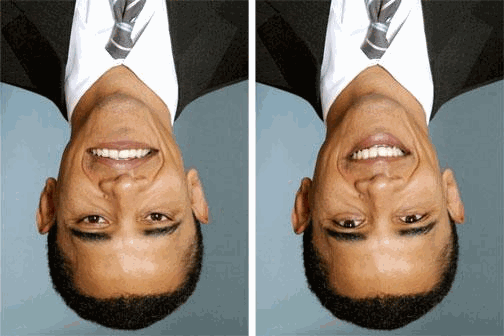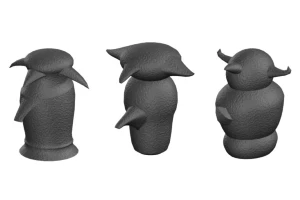Recognizing Faces: Exploring a domain-specific approach to object recognition
Vision science is among the best developed and vigorous research areas in the cognitive sciences. The study of low-level visual processing is concerned with issues such as how the retina transduces light and how the visual system extracts features and surfaces from retinal stimulation. The study of higher level visual processing is concerned with how those features are used to recognize objects. The issue is not merely how surfaces are segmented into separable objects (sometimes called “mid-level vision”), but how the visual system recognizes what category each object belongs to—that this one is a “dog”, that one a “car”, that one a “cup”. Whereas the study of low-level vision has flourished, the study of high level object recognition has not. How we recognize objects remains something of a mystery.
Why is object recognition so poorly understood?
Most vision scientists say progress has been slow because the problem is so difficult: Reverse engineering computational processes that can reconstruct and categorize whole objects on the basis of low-level smears on the retina is no small task. But progress may be slow for another reason as well: Vision scientists may be having trouble understanding object recognition because they are seeking processes that are too general. It could be that the visual system has several functionally distinct category-specific recognition systems—one for animals, another for plants, another for man-made tools, and so on.
Most vision scientists reason as follows: Since we are able to recognize objects from all kinds of categories—even evolutionarily novel ones—the processes of object recognition must themselves be domain-general. As a result, many scientists, such as Biederman and Marr, have taken approaches based on the general geometry of objects. This research has been interesting and valuable. Yet it has not led to a breakthrough in our understanding of object recognition.
An alternative view is that the object recognition system is composed of a variety of subsystems, at least some of which are specialized for recognizing categories of entities that have been very important during our evolutionary history. There is, for example, a reasonable amount of evidence that the visual system contains a subsystem specialized for recognizing human faces, and this claim is in no way inconsistent with the observation that we are capable of recognizing evolutionarily novel objects as well.
In fact, neuropsychological, fMRI, and developmental evidence suggests that semantic memory contains dissociable, category-specific subsystems for several evolutionarily important domains: Animals, people, plants, landscapes/ topographical landmarks, human-made artifacts, and personality traits (e.g., Caramazza & Shelton, 1998; Klein et al., 2002a, b). The visual system could have dedicated recognition processes for some of these categories as well. Perhaps the problem of object recognition has been difficult to crack because people are not looking for these specialized systems.
Recognizing Faces
Brad Duchaine started working on face recognition while he was a graduate student at the CEP, and he has continued to do so as a professor at Dartmouth College, where he heads the Social Perception Lab. His research asks whether there is a division of labor within face processing and within visual recognition more generally. That is, are there systems specialized for detecting faces, recognizing their identity, detecting facial expressions, recognizing the body, and so on.
Prosopagnosia is a neuropsychological condition that selectively impairs your ability to recognize individual faces. Most cases are acquired: that is, the person had a stroke or traumatic brain injury that caused their face deficit. But some people have developmental prosopagnosia: people who, due to genetic or congenital anomalies, never developed the ability to recognize faces. It is a rare condition—although many more cases have been identified since Duchaine and his colleagues started www.faceblind.org. (See the 60 minutes segment Faceblindness: When everyone is a stranger, with Brad Duchaine.)
What Duchaine realized early on is that people with developmental prosopagnosia (DP) offer a unique window on the cognitive, neural and developmental bases of face recognition.
A face deficit can arise from many causes. So how can we know there is a specialization for faces?
Evidence for a specialized system for face recognition comes from many sources. Perceptual illusions play a role–take a look below. Prosopagnosia also provides evidence, as do neuroimaging studies, TMS (you can see what a brain area does by preventing it from functioning for a few seconds with transcranial magnetic stimulation), twin studies and other methods.

- Compared to other objects, people are slower to recognize inverted than upright faces.
2. It is more difficult to detect feature distortions in inverted faces. Look at President Obama’s eyes and mouth in the left-hand photos.
But is prosopagnosia always caused by damage to a face specialization? Not necessarily. Duchaine had an important insight: To provide strong evidence for the domain-specificity of face recognition systems, one must rule out all of the domain-general alternative hypotheses in the same prosopagnosic individual.
Why? Many cognitive processes contribute to face recognition, so the same symptom—the inability to recognize faces—can have many different, independent causes: In some individuals it could be caused by damage to a domain-specific face recognition system, whereas in others it could be caused by damage to (say) configural processing mechanisms (these two causes will lead to different constellations of deficits, which are detectable through neuropsychological testing). So let’s say that testing rules out the hypothesis that Patient A’s prosopagnosia was caused by a deficit in a (domain-general) configural processing mechanism. It could nevertheless be true that this person’s face deficit is caused by damage to a different domain-general mechanism, say one for distinguishing between similar objects from the same category—like faces, which all look very similar (2 eyes, nose, mouth, all in specific places), horses all look very similar, and so do men’s dress shoes. The opposite could be true in Patient B. To support the notion that prosopagnosia can, in principle, be caused by damage to a system specialized for faces, one must therefore rule out all domain-general alternatives in the same individual.
Duchaine has tested scores of people with DP using these methods, and found a number with impairments only to their face recognition. Indeed, he has even found a case in which face recognition dissociates from recognition of emotional expressions on faces. Because they address the methodological concerns that had been raised against prior cases of purportedly selective face deficits, his studies provide some of the best evidence that a specialization for faces exists.
Even more interesting, however, are his developmental inferences. Developmental disorders can test alternative theories of how an ability was acquired—a method used to investigate language acquisition and theory of mind.
Are face specializations built by domain-general mechanisms?
Some psychologists acknowledge that the mind has computational specializations for face recognition. But they claim that these computational specializations are built by domain-general cognitive processes. In this view, cognitive systems specialized for faces exist, but they were built by adaptations for developing expertise in recognizing any object class with which we have lots of experience. I will call this the expertise hypothesis. Take a look at the greebles below—advocates of the expertise hypothesis use them because they vary subtly, like faces do.

“Families” of greebles have been created to test the expertise hypothesis. If prosopagnosia is caused by a disruption of mechanisms for acquiring visual expertise, then people with prosopagnosia should not be able to become expert at recognizing individual greebles.
Imagine we have no domain-specific systems specialized for learning to distinguish and identify faces. That would imply that computational specializations for face recognition in adults were acquired via domain-general systems for acquiring visual expertise. If this were true, a genetic, congenital, or other disorder that disrupts the development of this expertise acquisition system would cause developmental prosopagnosia—plus it would render the person incapable of acquiring expert recognition systems for any domain.
Yet this does not happen. Duchaine found a number of people with DP who have no trouble acquiring expertise in discriminating among very similar members of non-face stimulus classes—despite having severe face impairments. There are people with DP who have no trouble recognizing individual horses, individual cars—even individual men’s dress shoes (consider how similar they all look!).
Duchaine also gave people with DP the same training with Greebles given to undergraduates, to test their ability to acquire expertise with a novel stimulus class. There are people with DP who cannot recognize faces after a lifetime of experience, who can acquire expertise in recognizing Greebles. This is an important result: It shows that the system for developing expertise recognizing faces can be impaired without interfering with the system for developing expertise in other domains.
This pattern of preserved and impaired abilities would be impossible if face recognition developed via a domain-general learning process. In pursuing these studies, Duchaine has also elucidated the logic of developmental dissociations for finding specialized learning systems. See these papers by Stan Klein and colleagues, which apply the same logic to learning about personality traits. Here and here.
For an Economist article on Brad Duchaine’s work on prosopagnosia, click here.
Are there domain-specific processes within visual attention?
Other CEP research involves the discovery of domain-specialized systems governing visual attention. Joshua New’s research provides evidence of a system specialized for monitoring animals for changes in their state and location. Click here to find out more






